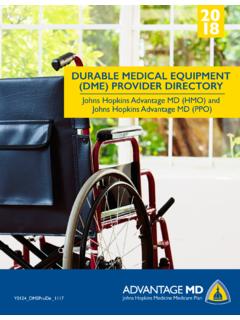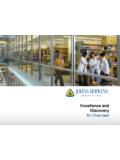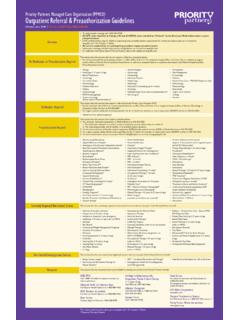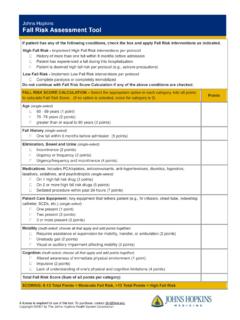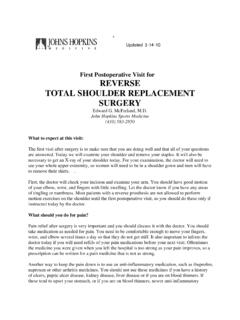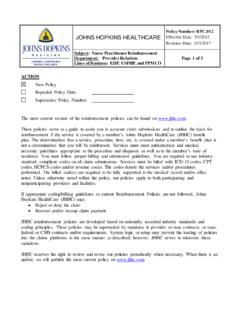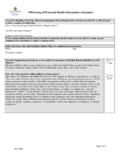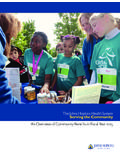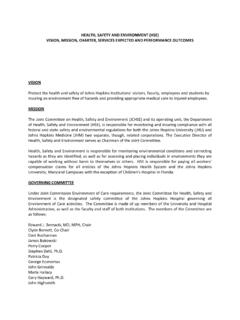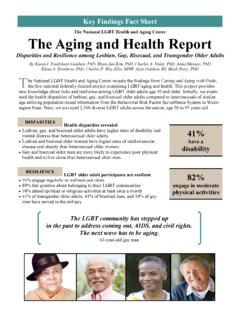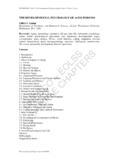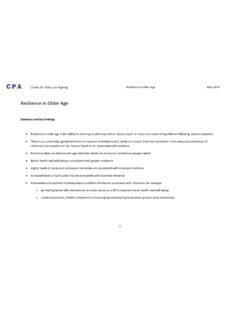Transcription of ˜ e Age of Resilience - Johns Hopkins Hospital
1 E Age of ResilienceInsight and news from Johns Hopkins MedicineFALL 2011 Get back in shape after a heart attackAre your child s worries cause for greater concern?Finally, a solution for stubborn leg woundsJohns Hopkins geriatricians help seniors stay healthy, vital and fitCompliments of Johns 19/29/11 1:06 PMExploring the Science of PleasureF A L L 2 011 QUICK CONSULT 4| Making a Strong Case for Cardiac Rehab Shape up after a heart attack. 5| Stopping Childhood Anxiety Before It Starts Hint: Start with family PERSON 10| A Leg Up on Vein Disorders Doctors heal a stubborn OPINION 11| Take Control Find relief for fecal |ON THE COVERThe Age of ResilienceAt Johns Hopkins , getting older means keeping your UP for Health Information from Johns and more! Get your free email subscrip-tion by visiting MORE ABOUTTHE COMPASS OF PLEASUREand its author, Johns Hopkins neuroscientist David J. Linden, , as well as his research, what fuels his interest in the biology of pleasure and what hangs on his of ce wall.
2 Visit to read more now. Health tips News about research and treatment options Healthy recipes Patient stories Reminders about Johns Hopkins seminars and health screenings VideosEACH MONTH, YOU LL RECEIVE:PROBIOTICS: Pros and ConsTHAT CERTAIN ACTIVITIES and substances are pleasurable is not news. But understanding why is the subject of continu-ous J. Linden, , a professor of neu-roscience at Johns Hopkins University School of Medicine, has signi cantly advanced our knowledge about pleasure. He published his ndings in the book e Compass of Pleasure: How Our Brains Make Fatty Foods, Orgasm, Exercise, Marijuana, Generosity, Vodka, Learning, and Gambling Feel So to Linden, everyone s brain has a pleasure circuit that is active during pleasurable activity. e pleasure circuit is activated both by vices, such as gambling, and virtuous activities, such as most people, the end result is pleasure. But in those who have variants in their genes that alter how signals are sent to the pleasure circuit, something else happens.
3 In the development of addiction, people move from a state in which they take pleasure from the substance or behavior and move into a place where they aren t taking much pleasure at all, Linden explains. ey just do it to avoid withdrawal or feeling bad. is area of study, which is ongoing, can help doctors better understand and treat the latest news on health and wellness topics important to you and your family, on everything from snoring to diets to state-of-the-art treatments? Sign up now to get trusted information from the experts at Johns Hopkins Medicine with Your Health, a new e-newsletter delivered straight to your Your Head About Concussion Recovery| 2 | Johns Hopkins health fall 2011 877-546-1872 | 29/29/11 1:06 PMhealthinsightsNEW BUILDINGS EXPAND OUR LEGACYTHERE IS A LOT OF TALK about how probiotics can help you achieve optimal digestive health. But which claims are true?Evidence suggests probiotics offer cer-tain health benefi ts, says Linda A.
4 Lee, , a Johns Hopkins gastroenterologist, but there is no proof yet that they re a cure-all. Probiotics may help some people who have diarrhea when they take antibiotics, or women with bloating from irritable bowel syndrome, she explains. They may also be helpful when used along with medical ther-apy in the treatment of ulcerative colitis. Probiotics exist in many different strains, and Lee recommends you ask your doctor or pharmacist about ones that have proved effective in clinical trials. As for yogurt, she says, be aware that not every brand contains the benefi cial your doctor says probiotics may help with a specifi c issue, Lee says a healthy diet is the best way to achieve optimal digestive : Pros and ConsWhen the new buildings open at The Johns Hopkins Hospital in April 2012, they will offer hotel-style amenities for patients, families and visitors to enhance every aspect of their experience. Designed with the patient in mind, the Sheikh Zayed Tower and The Charlotte R.
5 Bloomberg Children s Center will feature: All private patient rooms, private bathrooms, walk-in showers, and sleep sofas for families. A wide range of dining options, including a food court, gourmet market, and other restaurants and shops for different tastes. A two-story indoor play area, including a basketball court, for pediatric patients. A dramatic art collection featuring national and international artists. Artistically landscaped gardens for meditation and re ection. Valet parking and a close, convenient parking take a virtual tour of the new building or to learn more, visit Linda Lee, , and other Johns Hopkins experts at A Woman s Journey, Johns Hopkins Medicine s annual women s health conference, on Nov. 12. For more information, call 410-955-8660 or visit S HEALTH CONFERENCEUse Your Head About Concussion RecoveryIf your child has had a concussion while playing sports, he or she needs adequate time to recover before returning to the game.
6 How much time, says George Jallo, , a Johns Hopkins pedi-atric neurosurgeon, depends on the severity of the concussion and whether your child has symptoms, including neck pain, nausea, dizzi-ness, balance problems and sensitivity to light. Anyone who has had a concussion should wait at least one week after symptoms have cleared before returning to sports, he says. If your child has symptoms like a headache or trouble concentrating, it s too soon to even return to school. Jallo recommends asking your child s physician for the all-clear to return to school and THE DAT | 877-546-1872 fall 2011 Johns Hopkins health | 3 | 39/29/11 1:06 PMMaking a Strong Case for Cardiac RehabquickconsultTo learn more about cardiac rehab, visit For more information or to make an appointment, call a heart attack or heart surgery, your hardest working muscle needs to get back in shape. Stuart Russell, , director of heart failure and transplant at Johns Hopkins , explains why cardiac patients should take advantage of rehabilitative careCan you tell me more about the benefits?
7 There is improvement in survival and reduction in heart attacks after rehab. In a study of 21,000-plus patients nationwide, cardiac rehab led to a 17 percent reduction in heart attacks after one year and a 47 percent reduction after two years. older patients who went to rehab experienced an 88 percent reduc-tion in Hospital readmissions versus a 70 percent reduction in readmis-sions for those who didn t do cardiac rehab. It improves exercise capacity and leads to a decreased incidence of is cardiac rehabilitation?Cardiac rehab is a combination of exercise training, muscle/strength training, plus teach-ing people how to lead heart-healthy lives. It includes dietary education as well as work on either a bike or a treadmill, and weightlifting. Each session is about 30 minutes to an hour. Cardiac rehab saves lives, keeps you out of the Hospital and helps you feel do I sign up?Ask your doctor for a prescription. At Johns Hopkins , we use moni-tors that allow us to continuously measure your heart s electrical activity while you re exercising.
8 We also test your aerobic capac-ity, so we can prescribe the right amount of exercise to help you reach fitness goals. Also, if you come to Johns Hopkins , you have the opportunity to participate in research trials that help us improve care. But whether you come to us or go elsewhere, you need to go. nWho needs it? Cardiac rehab is for people who have suffered a heart attack, had a stent placed or undergone cardiac surgery. Insurance companies usually pay for 30 sessions after one of these cardiac events. Unfortunately, physicians send less than 20 percent of their cardiac patients to rehab.| 4 | Johns Hopkins health fall 2011 877-546-1872 | 49/29/11 1:06 PMALTHOUGH IT S PERFECTLY normal for children to worry some- times, it s not always harmless. One in 10 children ages 5 to 16 su ers from an anxiety dis-order, compared with one in 20 children who has the more widely known attention de cit/hyperactivity disorder (ADHD).General anxiety disorder (GAD) is a diag-nosable illness in children.
9 Ese are the kids who are the worriers, says Golda Ginsburg, , a professor and child psychologist at Johns Hopkins . ey worry about safety, mak-ing friends, school performance. It s chronic, severe and di cult to control. Ginsburg says these children seek a lot of reassurance, but reassurance doesn t reduce the anxiety can cause developmental problems in children because it often interferes with sleep, prevents them from going places, and a ects their interaction with is far more common in children than panic disorder, which occurs when a child has panic symptoms such as a racing heartbeat, di culty breathing and a feeling of loss of control. And experts know GAD can run in families. All anxiety disorders have a biological and environmental compo-nent, Ginsburg says. at s one reason Johns Hopkins research-ers are focusing on stopping anxiety before it starts by studying the children of parents who have been diagnosed with the disorder. Prevention is key, Ginsburg says.
10 If it s at the disorder level, she adds, then treatment is needed. To treat children su ering from anxiety, doctors generally will use cognitive behav-ioral therapy or medication, or both. A 2008 study by Johns Hopkins researchers showed that combination therapy was most e ective, with 80 percent of combination-treated children showing improvement; in a more recent study, however, symptoms improved but in many cases the illness didn t go away entirely. Pay attention to three clues that your child may have higher-than-normal levels of anxiety or worry:If you are struggling with anxiety and are concerned that your child could suffer from it, too, Johns Hopkins is seeking participants for a clinical trial on prevention strategies for childhood anxiety. Call 443-287-4349 or email for more Do I Know If My Child Has Anxiety?Stopping ChildhoodANXIETYB efore It StartsARE YOUR KIDS AT RISK? CHECK YOUR FAMILY HISTORY1 Severity. How out of proportion is the worry to the problem?
